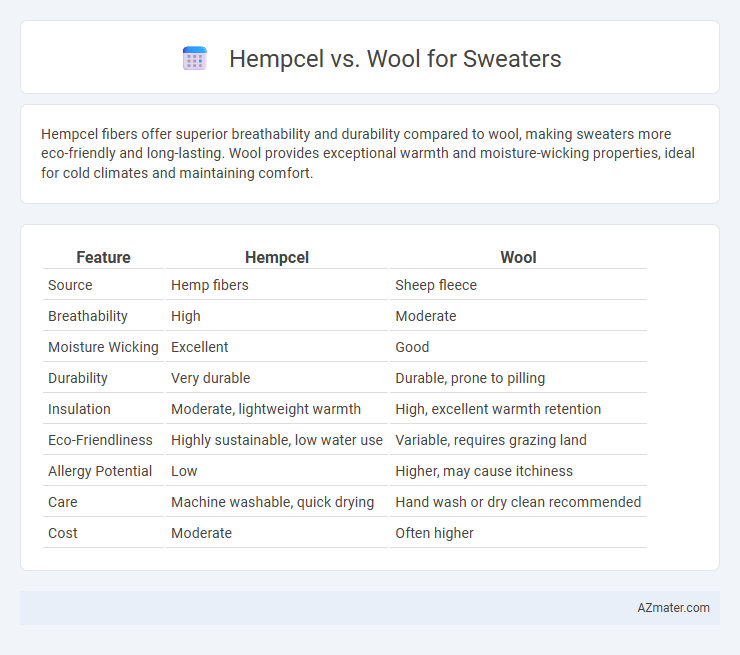Hempcel fibers offer superior breathability and durability compared to wool, making sweaters more eco-friendly and long-lasting. Wool provides exceptional warmth and moisture-wicking properties, ideal for cold climates and maintaining comfort.
Table of Comparison
| Feature | Hempcel | Wool |
|---|---|---|
| Source | Hemp fibers | Sheep fleece |
| Breathability | High | Moderate |
| Moisture Wicking | Excellent | Good |
| Durability | Very durable | Durable, prone to pilling |
| Insulation | Moderate, lightweight warmth | High, excellent warmth retention |
| Eco-Friendliness | Highly sustainable, low water use | Variable, requires grazing land |
| Allergy Potential | Low | Higher, may cause itchiness |
| Care | Machine washable, quick drying | Hand wash or dry clean recommended |
| Cost | Moderate | Often higher |
Introduction: Hempcel and Wool Sweaters Compared
Hempcel sweaters offer exceptional breathability and durability due to hemp fibers' natural strength and moisture-wicking properties, making them ideal for sustainable fashion enthusiasts. Wool sweaters provide superior insulation and warmth through lanolin-rich fibers, suited for cold weather comfort and thermal regulation. Comparing Hempcel and wool highlights distinct benefits in sustainability, texture, and climate adaptability for varied sweater preferences.
Material Origins: What Are Hempcel and Wool?
Hempcel is a sustainable fabric derived from hemp fibers, known for its durability and eco-friendly cultivation process requiring minimal water and pesticides. Wool comes from the fleece of sheep, offering natural insulation, moisture-wicking properties, and biodegradability. Both materials reflect distinct origins--Hempcel from plant-based sources promoting sustainability, and wool from animal fiber with traditional textile benefits.
Sustainability and Environmental Impact
Hempcel sweaters offer superior sustainability compared to wool due to hemp's rapid growth cycle and minimal pesticide requirement, significantly reducing environmental strain. Wool production involves methane emissions from sheep and land degradation, making hemp fiber a more eco-friendly alternative with lower greenhouse gas outputs. Hempcel's durability and biodegradability further enhance its environmental benefits, providing a sustainable choice for eco-conscious consumers.
Softness and Comfort: How They Feel
Hempcel sweaters offer a unique blend of durability and breathability, providing a lightweight and slightly textured feel that becomes softer with wear, making them ideal for those who prefer natural, eco-friendly fabrics. Wool sweaters, on the other hand, are renowned for their exceptional warmth and plush softness, delivering superior insulation and a cozy comfort that adapts to body heat. While wool excels in softness and warmth, Hempcel stands out for its moisture-wicking properties and a comfortable, airy fit that is less prone to itching.
Warmth and Insulation Properties
Hempcel fibers offer excellent breathability and moisture-wicking properties but provide moderate insulation compared to wool, making them suitable for mild to cool temperatures. Wool excels in warmth and insulation due to its crimped fibers trapping air, offering superior thermal regulation and moisture resistance in colder conditions. Choosing between hempcel and wool for sweater warmth depends on the climate, with wool being optimal for cold weather and hempcel favoring comfort in transitional seasons.
Durability and Longevity
Hempcel fibers exhibit superior durability compared to wool, boasting high tensile strength and resistance to wear, making hemp sweaters longer-lasting under intensive use. Wool provides natural resilience and elasticity but tends to degrade faster with repeated washing and abrasion. Choosing hempcel ensures enhanced longevity and sustained fabric integrity for sweater garments.
Breathability and Moisture Wicking
Hempcel fibers offer superior breathability compared to wool, allowing air to circulate freely and keep the wearer cool during warm conditions. Hempcel's natural moisture-wicking properties efficiently draw sweat away from the skin, promoting faster evaporation and dryness, whereas wool can retain moisture longer, which may cause discomfort. Both materials provide insulation, but Hempcel's enhanced breathability and moisture management make it ideal for activewear and warm-weather sweaters.
Care and Maintenance Requirements
Hempcel sweaters require minimal care, as hemp fibers are naturally resistant to mold, UV rays, and wear, making them machine washable and quick-drying without losing shape or strength. Wool sweaters need more careful maintenance, often requiring hand washing or dry cleaning to prevent shrinking and felting, and should be dried flat to maintain their structure. Both fibers benefit from proper storage in a cool, dry place, but hempcel's easier maintenance makes it ideal for everyday wear.
Price and Accessibility
Hempcel sweaters typically cost more than wool due to sustainable production methods and limited availability, making them less accessible in mainstream markets. Wool sweaters, widely produced and available in various price ranges, offer greater affordability and easier accessibility through numerous retailers worldwide. Consumers prioritize wool for budget-friendly options, while Hempcel appeals to niche markets valuing eco-friendly textiles.
Final Verdict: Which Sweater Material Reigns Supreme?
Hempcel offers superior durability, breathability, and eco-friendliness, making it an excellent choice for sustainable sweater materials. Wool provides unmatched warmth, natural moisture-wicking, and a cozy texture ideal for cold climates. The final verdict favors hempcel for those seeking durability and sustainability, while wool remains the top pick for warmth and traditional comfort.

Infographic: Hempcel vs Wool for Sweater
 azmater.com
azmater.com